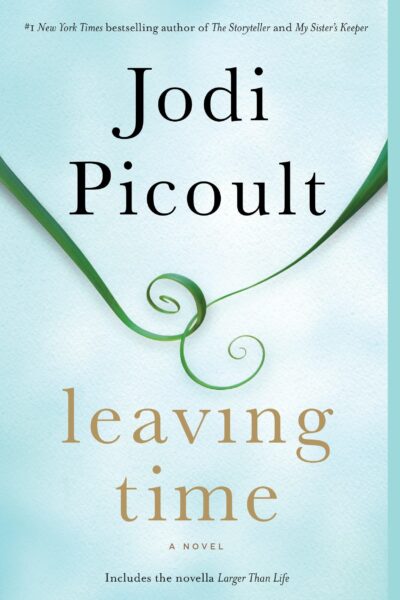
Leaving Time
Chapter 43: Jenna
by Picoult, JodiThe chapter “Jenna” from *Leaving Time* explores themes of memory, loss, and the deep connections between humans and elephants. The narrator, Jenna, describes visiting her mother during the twilight hours between night and morning, where her mother shares stories about her work with orphaned elephants. These tales serve as a substitute for the bedtime stories Jenna missed during their separation, highlighting the emotional void left by her mother’s absence and the comfort found in their reunions.
One of the stories Jenna’s mother recounts is about Lawrence Anthony, known as the Elephant Whisperer, who rescued and rehabilitated wild elephants in South Africa. When Anthony passed away, the elephants he saved traveled a great distance to mourn at his home, despite not having visited in over a year. This anecdote underscores the profound bond between humans and elephants, as well as the animals’ seemingly inexplicable awareness of human emotions and events.
Jenna reflects on the mystery of how the elephants knew of Anthony’s death, offering her own interpretation: love transcends physical presence. She suggests that merely thinking about a loved one who has passed away creates a connection, making the physical details of their absence irrelevant. This idea ties back to her visits with her mother, implying that their bond persists despite separation or loss.
The chapter concludes with Jenna’s poignant realization that emotional connections defy explanation and endure beyond physical boundaries. Her mother’s stories about elephants mirror her own experiences of love and loss, illustrating how memories and thoughts keep loved ones close. The narrative blends personal reflection with broader themes of interspecies empathy, leaving readers with a sense of wonder about the unseen ties that bind us all.
FAQs
1. What is the significance of the “in-between time” when Jenna visits her mother?
Answer:
The “in-between time” refers to the transitional period between night and morning, which holds symbolic importance in the chapter. This liminal space represents a threshold where connections between the living and the deceased feel possible. Jenna’s mother always wakes during these visits, suggesting an enduring bond that transcends physical absence. The timing also mirrors the chapter’s themes of blurred boundaries—between memory and presence, loss and connection—reinforced by Jenna’s reflection that “if you think about someone you’ve loved and lost, you are already with them.”2. How does the anecdote about Lawrence Anthony deepen the chapter’s central themes?
Answer:
The story of Lawrence Anthony, the “Elephant Whisperer,” parallels Jenna’s mother’s dedication to elephants and underscores themes of unbreakable bonds. Anthony’s rehabilitation of wild herds mirrors Jenna’s mother’s work with orphans, while the elephants’ unexplained vigil after his death becomes a metaphor for Jenna’s own visits. This anecdote bridges the scientific (elephant behavior) and the spiritual (inexplicable connection), illustrating how love and memory defy logical explanation—a idea Jenna explicitly endorses when she states, “No one can explain how the elephants knew… I know the answer.”3. Analyze the significance of Jenna comparing her mother’s stories to “bedtime stories I missed.”
Answer:
This comparison reveals Jenna’s unresolved grief and longing for maternal connection. By framing her mother’s updates about elephant orphans and speeches as “bedtime stories,” Jenna retroactively fills an emotional void from her childhood. The phrase highlights what was lost (traditional mother-daughter rituals) while affirming what persists: her mother’s voice and legacy. It also reflects Jenna’s active role in reconstructing their relationship through memory, aligning with the chapter’s assertion that remembrance itself constitutes a form of presence.4. How might the chapter’s closing lines (“If you think about someone… just details”) apply to real experiences of grief?
Answer:
These lines propose a radical redefinition of loss, suggesting that emotional connection transcends physical separation. In practice, this perspective could comfort grievers by validating memories, dreams, or sensory impressions of loved ones as authentic encounters. However, it also challenges conventional notions of closure—Jenna’s ongoing visits imply grief need not “end.” The idea may resonate with those who find solace in symbolic connections (e.g., feeling a loved one’s presence in nature) but could complicate healing for others who require tangible boundaries between life and death.5. Why does the author juxtapose Jenna’s personal narrative with scientific observations about elephant behavior?
Answer:
The juxtaposition creates a thematic dialogue between empirical evidence (elephants’ documented mourning rituals) and subjective experience (Jenna’s visits). This contrast invites readers to consider grief as both a universal biological phenomenon and a deeply personal journey. By aligning Jenna’s story with the elephants’ vigil for Anthony, the author implies that human and animal emotional intelligence share common ground, elevating Jenna’s mystical connection with her mother from mere metaphor to a plausible, natural phenomenon rooted in observable reality.
Quotes
1. “Sometimes, I go back and visit her. I go during the in-between time, when it’s not night and it’s not morning.”
This opening line establishes the chapter’s haunting, liminal tone and introduces the narrator’s ongoing connection with someone (likely her mother) despite physical separation. The “in-between time” suggests these visits exist outside ordinary reality.
2. “I think of these as the bedtime stories I missed.”
This poignant reflection reveals how the narrator is reclaiming lost moments of childhood through these visits. It underscores the chapter’s themes of memory, loss, and the enduring need for parental connection.
3. “When Lawrence Anthony died, the two herds traveled through the Zululand bush for more than half a day and stood outside the wall that bordered his property… The elephants stayed for two days, silent, bearing witness.”
This powerful anecdote about the Elephant Whisperer illustrates the deep, inexplicable bonds between humans and elephants - a central theme in the book. The elephants’ mourning ritual mirrors human grief patterns.
4. “If you think about someone you’ve loved and lost, you are already with them. The rest is just details.”
This concluding insight forms the chapter’s emotional core, suggesting that love transcends physical presence through memory. The simple yet profound phrasing makes it particularly memorable and universally resonant.
